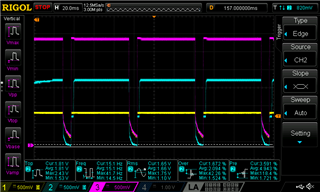My design has two channels, each utilizes a bunch of SN65HVD1781-Q1 transceivers and they share a bus on a single PCB. Each channel has common bus, but separate power (but with common ground) and separate HW watchdog.
When I powered up one channel it seemed that everything was working fine, however upon powering up the second channel while first one is active (but no traffic there - transceivers are powered up but idle) power buses (in this case +3V3) do not drop to 0V during the watchdog reset unless both of the watchdogs disable the power at the same time.
I have de soldered the transceivers from one channel and voltages on power rails are now dropping to 0V.
Next I have prepared a simple test board with only said transceiver on it, and connected it to the bus and GND as shown on schematic below:
and here are the results (mind that those negative peaks towards 0V is watchdog's doings) :

Looks like the transceiver is draining power from the bus to me, am I wrong?
Is this expected to be like that?

